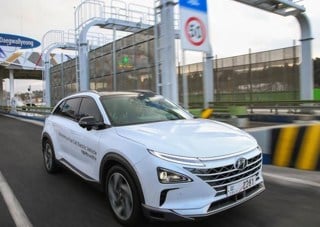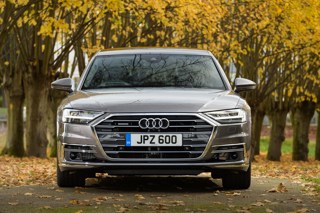Self-driving vehicle tests will not be halted in the UK after a pedestrian was killed by a fully autonomous car operated by Uber in the US.
A 49-year-old woman was struck by the vehicle as she crossed the street in Tempe, Arizona. The cause of the incident is being investigated.
The Department for Transport (DfT) told Fleet News that safety remained paramount to UK tests, which is why it said it was investing more than £250 million to support the industry with “full and proper trials and safe testing environments”.
“We will continue to work closely with industry to ensure the UK remains one of the best and safest places in the world to test self-driving vehicles,” said a Government spokesman.
Uber suspended all North American tests of its autonomous vehicles after the fatal collision on March 18. Its partner, chipmaker Nvidia, said it has also suspended all self-driving tests.
Arizona state governor, Doug Ducey, also ordered officials to suspend Uber’s right to operate autonomous vehicles on local roads pending the outcome of inquiries by national transport safety regulators.
Here, roads minister Jesse Norman had already announced a three-year review of driving laws by the Law Commission of England and Wales and the Scottish Law Commission to enable autonomous cars to be developed and tested in the UK.
The Government spokesman said the “extensive regulatory reform programme” would make sure that “the right laws are in place before the widespread use of these vehicles on UK roads”.
In the meantime, UK on-the-road testing will continue, but operators stressed that safety continued to be their number one priority.
UK test locations
UK Autodrive has been conducting tests in Milton Keynes and Coventry, Venturer in Bristol and the Greenwich Automated Transport Environment (GATEway) Project in Greenwich, London.
The GATEway Project, led by TRL (Transport Research Laboratory) is funded by Government and industry and aims to demonstrate the use of automated vehicles for ‘last mile’ mobility.
Camilla Fowler, head of risk management at TRL, said: “Safety has been a key focus throughout the GATEway trials. In the absence of formal safety standards, we have developed a safety case that demonstrates the risks to all affected parties have been identified, managed and reduced to a tolerable level.”
Fowler explained that they have “trained and competent safety stewards” in all pods who monitor other route users and vehicle functionality.
“Safety stewards are ready to either reduce the speed of the vehicle to walking pace or stop the vehicle entirely if a hazardous situation arises or the vehicle is not operating as expected,” she said. “We are also fully aware of fatigue and distraction and have taken measures to minimise these risks.
“The mitigations we have put in place were reviewed by an expert panel to provide additional assurance that the safety case is fit for purpose.”
Venturer’s trials have taken place in the laboratory and on the roads of the University of the West of England (UWE, Bristol) campus.
A spokesman told Fleet News: “We believe the UK Government’s approach, which we support, underlines the need for rigorous testing and a step-by-step process to safely integrating connected and automated vehicles in the UK.
“For this reason, it is important that investment in research and development activities continues to support the robust testing and safe introduction of such vehicles.”
Manufacturers involved in developing self-driving vehicles, including PSA and the VW Group, also appeared undeterred by the incident.
VW Group, which plans to launch fully autonomous electric cars, vans and trucks in controlled environments in 2021, said it had no reason to rethink its plans.
PSA, which has been testing self-driving technologies on French roads, also said the Uber incident would not change its current self-driving tests.
Toyota, however, has suspended US tests of driverless cars on public roads following the fatality. The manufacturer said it was concerned about the “emotional effect” the incident might have on its test drivers and did not have a timeline for re-starting the trials.
LESSONS WILL BE LEARNED
US police said the Uber crash, which involved a modified Volvo XC90, happened at night while the car was in autonomous mode. A human monitor was also behind the wheel.
The death came a year after Uber took its self-driving cars off the road following an accident that left one of its Volvo vehicles on its side in Arizona. The programme was later reinstated after it was deemed to be at-fault.
Uber agreed in November, 2017, to buy 24,000 Volvos on to which it planned to install its own sensors and software to permit pilot-less driving.
Bloomberg reported that Uber had disabled the standard collision-avoidance technology in the Volvo which struck and killed the woman in Arizona, according to Aptiv, the auto-parts maker that supplied the vehicle’s radar and camera.
Aptiv’s radar and camera system uses chips and sensors to help power the Volvo XC90’s driver-assistance system, which provides collision avoidance, lane-keeping aid and other safety features.
Uber has declined to comment, while Volvo said the company would not speculate on the cause of the incident and is awaiting a full investigation report.
Fowler said: “Lessons will be learned for the industry as a whole from the US fatality and we are very interested to hear the findings from the investigations.”
Volvo announced in December that it was developing its own autonomous cars with help from a small number of Swedish families who will test its XC90 on the public roads of Sweden’s second-largest city, Gothenburg.
Three more families are set to follow suit, and over the next four years up to 100 people will be involved in the project called Drive Me.
During the first stage of the project, the families will keep their hands on the steering wheel and supervise the driving at all times when using their cars.
But, over time, all participants in the Drive Me project will gradually be introduced to more advanced assisted-driving cars, after receiving special training.
Even then, testing these more advanced cars will initially take place in controlled environments with supervision from a Volvo Cars safety expert. No technology will ever be introduced if there is any question over its safety, it said.
Volvo Cars plans to have a fully autonomous car commercially available by 2021, and the data derived from the Drive Me project, it says, will play a crucial role in the development of these vehicles.
Volvo Cars chairman Li Shufu, the head of Volvo owner Zhejiang Geely Holding, said that it was important for automakers and governments to look at regulations and what sort of standards were needed to keep people safe.
“The accident reminds us that no matter how fast we develop, safety is the number one priority,” he said. “If safety cannot be guaranteed, no automated cars .”
CHALLENGES REMAIN
Dr Jenifer Baxter, head of engineering at the Institution of Mechanical Engineers (IME), believes the US death serves to draw attention to the challenges of incorporating autonomous vehicles into an incumbent system operating with manned vehicles, cyclists, pedestrians and other road users.
In 2016, the IME published a case study on autonomous and driverless cars that raised the need to address societal questions before highly and fully automated cars are both accepted and legally able to be positioned on UK roads.
“This will include having the right regulatory framework in place,” said Baxter. “Engineers will need to create an environment where connected autonomous vehicles can operate safely with or without an operator during the transition period to a fully autonomous vehicle system. This transition period could last for several decades.”
It remains to be seen how far the death in the US will also damage public perception of the technology.
Fowler said she didn’t know whether the incident has damaged perception of the technology, but she had not seen a reduction in footfall or interest in the GATEway trials.
However, she concluded: “We cannot be complacent and must learn as much as we can from this incident to benefit society as a whole.
“No entity or organisation should seek to gain a competitive advantage from knowledge acquired from incidents involving their own vehicles – it must be a ‘duty of care to share’ such evidence to prevent future tragedies on our roads. This open approach will certainly, in my opinion, help to reassure the public and overcome any negativity.”























Nigel Boyle - 09/04/2018 13:29
Perhaps the accident may not have happened had the Volvo system been intact. I have one and it screams at me if it thinks I am close to something and slams the breaks on.